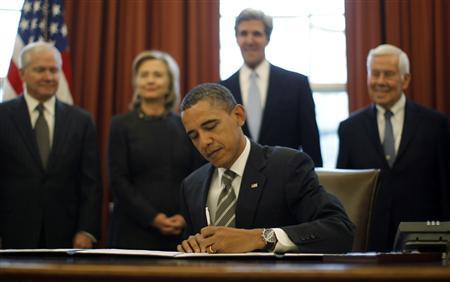The United States and Russia have huge arsenals of nuclear weapons. Since the end of the Soviet Union and the Cold War, there have been disarmament treaties between the U.S. and Russia, including several Strategic Arms Reduction Treaties (START)," which have reduced nuclear arsenals in the two nations from the tens of thousands of warheads that existed at the height of the Cold War to a few thousand each today. Russia decommissioned tens of thousands of nuclear warheads and sold the nuclear materials to the U.S. to make fuel for nuclear reactors. Until recently, the trends favored an end to the insane doctrine of "mutually assured destruction" that was the basis of the Cold War stalemate. Unfortunately for the human race, relations between the two countries have been deteriorating, exacerbated by the Russian seizure of Crimea from Ukraine in early 2014.
A senior Russian military official recently stated that "continued hostility may change the way Russia views the Strategic Arms Reduction Treaty." He said that given the attitude of the United States towards Russia these days may result in Moscow changing its policies towards the treaty. On the other hand, the top Russian diplomat has said that current tensions between the U.S. and Russia will have no effect on Moscow's disarmament program. He went on to say that START is still in effect and both the U.S. and Russia say that they are implementing its provisions. He also said that neither the U.S. nor Russia have expressed any concerns with the other nation with respect to START.
The current version of START was signed in 2011. Under its terms, the U.S. and Russia are both allowed to have a maximum of one thousand five hundred and fifty nuclear warheads and seven hundred delivery systems. Considering that there are estimates that the detonation of as few as one hundred nuclear warheads could be sufficient to cause a "nuclear winter" that would bring the end of human civilization, the START numbers seem overly generous.
In June of 2013, U.S. President Obama suggested a further reduction in nuclear arms. Russian President Putin replied that Russia could not afford to take such steps in view of U.S. weapons development and missile defense systems. Putin said that Russia will continue working on space defense as a key element of the entire Russian defense system. In spite of stiff sanctions imposed by other nations after the seizure of Crimea, Russian officials said that there would be no cuts to their military budget NATO. He said that conventional Russian forces could take on NATO forces but that if Russia were losing such a fight, he would consider unleashing tactical nuclear weapons against NATO. He has also spoken about the possibility of moving nuclear weapons into Crimea.
Both the U.S. and Russia have announced plans for upgrading their nuclear arsenals. The war of words continues as Russia slides towards economic collapse. Putin's belligerence in Eastern Europe has helped maintain his popularity with the Russian people but threatens to start a new Cold War. Although further arms reductions seems unlikely in the near future, we can hope that someday, the huge nuclear arsenals in the U.S. and Russia will be reduced to zero.
Obama signs START 2011:
